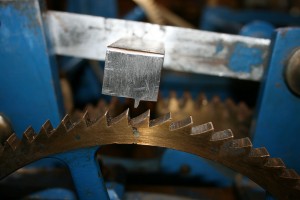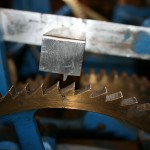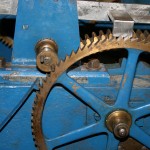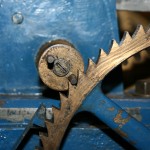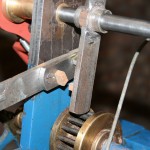We assumed the striking and chiming control mechanisms were the same, however we found a subtle but important difference. At first we were unable to get the mechanism to run correctly. It just didn’t work from any obvious starting point of the two pin pinion.
The significance of the two pin pinion is that the ratchet wheel does not move in a continuous manner but rather in steps (two per revolution of the arbour). The equivalent wheel on the chiming train moves continuously.
This is important because the ratchet wheel, which contains the lifting pin, must move at the start of the striking process (to allow the horizontal arm to drop) and at the end (to lift the arm back up). For the striking train it moves one step per hour being struck. Considering the striking of one o’clock, where the ratchet wheel only moves one tooth, it is clear that there must be movement of half a tooth at the start and half a tooth at the end of striking. That means the rest position of the ratchet wheel must be mid-movement, so the spring pawl cannot sit in a fully engaged position at rest, it needs to sit half way between teeth. This doesn’t seem like a natural resting position, but it does work. When at rest one of the pins is engaged with the ratchet wheel and when the pin comes out of mesh the pawl is engaged. The result is that either a pin or the pawl is always engaged with the ratchet wheel to prevent it moving inappropriately.
The fly arbour rotates five times per tooth of the ratchet wheel / strike of the bell.
To strike one o’clock:
- The first rotation of the fly arbour moves the ratchet wheel half a tooth, the two pin pinion disengages from the ratchet wheel and the spring pawl engages. This movement is enough for the horizontal arm to drop off the lifting pin on the ratchet wheel.
- The fly arbour then rotates freely for four turns, the two pin pinion remains out of mesh with the ratchet wheel.
- In the final half rotation the second pin in the pinion engages with the ratchet wheel and moves it half a turn. This causes the lifting pin to raise the horizontal arm and stop the striking mechanism.
- The rest of the mechanism works just like the chiming mechanism.
The lifting projection has to be very slim so it isn’t able to accommodate much of a ramp – the pictured projection doesn’t look like it would work but it does, in fact it works very well. Note the pictures showing the resting positions of the ratchet wheel, pawl and two pin pinion. There is also a picture showing how the positions of the blocks were prototyped in wood (attached with double sided tape).
